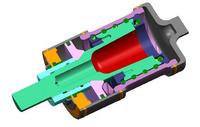New Roll Control System From BWI Group Improves Safety, Comfort And Agility With Reduced Weight Compared With Previous System
BWI’s new Twin Channel system gives instantaneous control of understeer/oversteer characteristics
PARIS – May 28, 2010: Global braking and chassis systems specialist BWI Group has developed a new ultra-compact version of its Active Stabiliser Bar System (ASBS) that helps to provide exceptional handling combined with best-in-class ride. The new system brings additional comfort benefits in addition to improving the dynamic abilities of the vehicle. The breakthrough has been achieved by developing a unique architecture that also reduces system weight by around 30 percent.
A traditional stabiliser bar (anti-roll bar) improves vehicle stability through corners by reducing roll angle and managing the tyre to road interface. Heavy vehicles with a high centre of gravity, such as SUVs (Sport Utility Vehicles), typically require stiff, large diameter stabiliser bars but these will substantially reduce ride comfort and refinement and can also reduce traction in some conditions. Conventional stabiliser bars also restrict wheel travel, potentially compromising off-road behaviour, and can create an effect known as ‘head toss' [1] that can be particularly uncomfortable in vehicles where the occupants are seated high.
BWI’s ASBS technology minimises all of these issues by splitting the conventional stabiliser bar in the middle. At the intersection of the two roll-bar sections, a computer-controlled actuator applies a variable level of torque. When the vehicle is travelling in a straight line, the system effectively de-couples the stabiliser bars from the vehicle, improving ride comfort and allowing large wheel articulation to increase off-road ability. In a corner, roll-stiffness is instantly increased by applying torque to each end of the bar. For the new generation system, BWI has developed a Twin Channel architecture that links the control of front and rear roll stiffness to give real-time control of the vehicle’s tendency to understeer or oversteer.
“Our system allows vehicle manufacturers to adjust the front-rear balance in real time so that the understeer or oversteer characteristics are continuously optimised for the demands of each driving situation,” explains Olivier Raynauld, BWI’s Manager, Forward Engineering Controlled Suspensions. “This means that the same vehicle can be agile in the city at low speeds, stable on the highway at higher speeds and provide improved stability during lane changing by adapting to help initiate the turn then resisting overshoot afterwards.”
Head toss occurs when the vehicle negotiates road undulations that are out of phase between left side and right side wheels, causing the occupants’ heads to be tossed alternately left and right across the vehicle; it is often made worse by stiff stabiliser bars in conjunction with soft springs and dampers.
BWI has also eliminated the tendency of pressurised actuators to exhibit a dead band (known as a discontinuity) around their centre position; an issue that otherwise necessitates complex management. “Existing systems control the flow of fluid between two sides of an actuator,” says Raynauld. “We control the pressure difference between the two sides and that means we avoid a discontinuity at the central position.”
BWI claims that the improvements are so significant that the new system can deal with all the vehicle roll angle and roll velocity inputs, leaving the springs and dampers to deal with just vertical inputs and eliminating a major source of compromise in the ride and handling balance. The twin channel approach is suitable for both linear and rotary actuators and will improve the comfort and stability of most vehicle types including sports cars, luxury cars and SUVs. The first production application of new generation roll control system is scheduled for 2012. BWI currently supplies roll control systems for the Land Rover Discovery and the Range Rover Sport.
BWI also supplies a wide range of other chassis control technologies to various vehicle manufacturers worldwide including electronic stability systems, variable damping systems and antilock braking systems.



